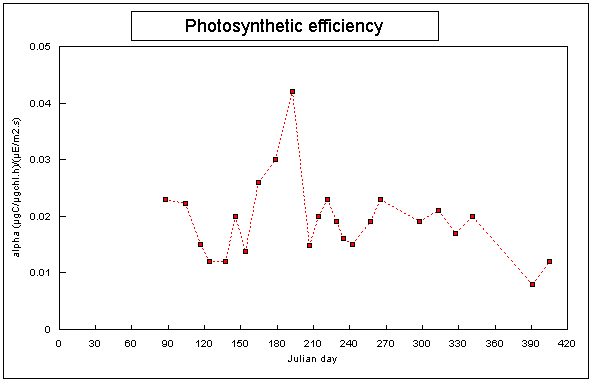

 |
Theme 7 |  |
The river Scheldt and the Western Scheldt estuary are vital to the economies of Belgium and The Netherlands
and these systems are subjected to severe anthropogenic stress. As a matter of fact, important loads of organic
matter and nutrients (NH4+, NO3-, PO43-) are
released from wastewaters and by fertilizers leaching into the
upstream waters and, hence, the estuary. It follows an eutrophic situation that is often the source of an
imbalance in carbon cycle since it allows phytoplancton to grow excessively from early spring until september.
The respiration of the decayed algal biomass by bacteria leads rapidly to a depletion of the dissolved oxygen
in the water column and this results in the death of the higher organisms and the deterioration of the water
quality as a tool for human activities.
The purpose of this work is firstly to evaluate, by means of experimental ground measures, the main parameters
controlling the intensity of the primary production in the Scheldt estuary (e.g.: light intensity, nutrients,
salinity, temperature, pH, alcalinity, dissolved O2...); and secondly to establish, on the basis of the harvested
datas, experimental laws describing the main biological processes (e.g.: gross & net primary production, algal
mortality, respiration, chemoautotrophic production, grazing...). This will allow us to build up a biological model
centered on the primary production of the phytoplancton that will be coupled to the previously developped
hydrodynamical model of the Scheldt estuary «CONTRASTE» (Coupled Networked Transient-Reaction Algorithm for
Strong Tidal Estuaries).
The Scheldt estuary dynamic is dominated by strong tides and low inflows of fresh waters. An important consequence
of it is that the water column is vertically well mixed. It ensues a long residence time of the freshwater in the
estuary and a large throw-in of the deposits in suspension causing a high turbidity in the water column. Hence,
the primary production by phytoplancton is fairly limited by light availability during the bloom whereas nutrients
are in excess of growth demand.
The influence of light intensity on phytoplancton growth is studied by means of
H14CO3- incorporations under variable
light. Platt’s exponential equation is used to fit the experimental curves and the photoinhibition term is neglected
since it is not observed.
mchl = mchl
max [1 - exp (-a I
/ mchl
max)]
Where: mchl is de specific growth rate;
In our case, the photosynthetic efficiency (a), reflecting the physiological
structure of the phytoplancton
light-harvesting pigments, is the main parameter controlling the gross primary production (GPP) during the bloom
because under low light conditions, the specific growth rate depends linearly on a
,as shown below:
mchl = a
. I
With I <<<
GPP = m
chl .Cchl
. Z . t
Where: Cchl is chlorophyll-a concentration;
As an example of our first results, the evolutions of photosynthetic efficiency
(a) and integrated gross primary
production (GPP) during 1999/2000 are shown for the upper estuary (Antwerp), where maxima of chlorophyll-a and
minima of dissolved O2 occur
(see: fig. 1 and 2).
Figure 1:Photosynthetic efficiency of the phytoplancton during 1999/2000 in
the upper Scheldt estuary.The origin corresponds to 1/1/1999.

mchlmax is the maximum photosynthetic capacity;
a is the photosynthetic efficiency and
I is the photosynthetic available light intensity.
Z is the euphotic depth and
t is the photoperiod.
We see an obvious correlation between the graphs during the
bloom period from june to late september (day 150 to 270). Outside the bloom period, low light availability and
low temperatures, among other environmental factors, limit the gross primary production despite high values of
photosynthetic efficiency.
